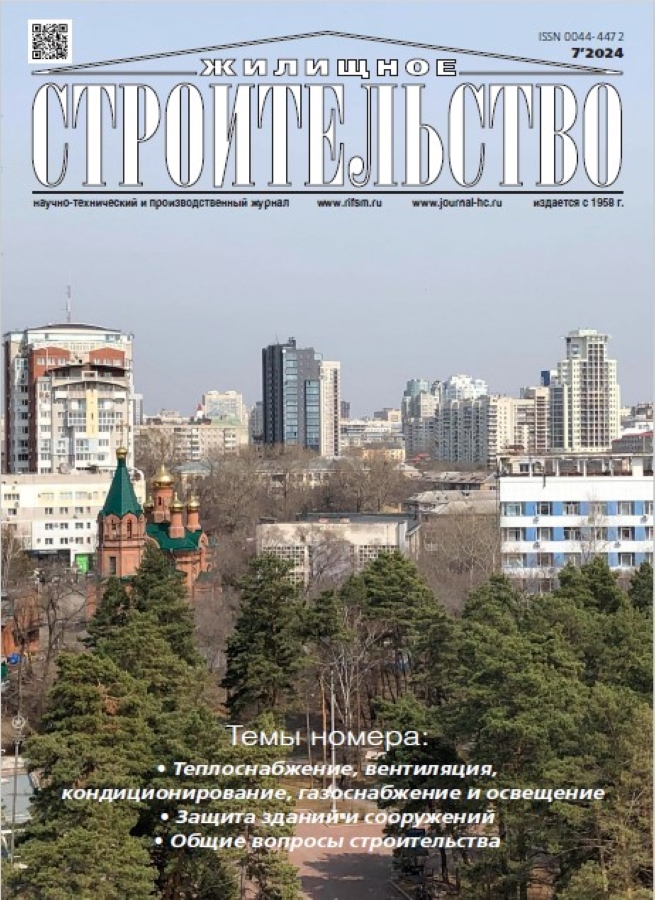Designing a device for determining the resistance of roofing materials to impact of hail
- 作者: Kashurkin A.Y.1,2, Plyusnina E.V.1, Melnikova I.V.2
-
隶属关系:
- Scientific-Research Institute of Building Physics of RAACS
- National Research Moscow State University of Civil Engineering
- 期: 编号 7 (2024)
- 页面: 16-21
- 栏目: Articles
- URL: https://modernonco.orscience.ru/0044-4472/article/view/634799
- DOI: https://doi.org/10.31659/0044-4472-2024-7-16-21
- ID: 634799
如何引用文章
详细
The territory of the Russian Federation can be divided into areas characterized by varying degrees of hail hazard. Most of them are occupied by territories with a low degree of hail hazard. The southern territories of Russia are located in an elevated hail fallout zone and are an important part of the country’s economy. Roofs and facades of buildings and structures also fall under the influence of hail, which leads them to an inoperable and emergency condition. Facade panels, light openings, roofing, drains, ventilation shafts, parapets fall under the blows of hail. GOST R 57414–2017 “Roofing and waterproofing flexible bitumen-containing and polymer materials (thermoplastic and elastomeric)” describes a method for determining resistance to impact of hail. In accordance with it, an installation for testing roofing materials was prepared. The work of a pneumatic device simulating hail, which will later be called a “HAIL CANNON”, has been studied.
全文:
作者简介
A. Kashurkin
Scientific-Research Institute of Building Physics of RAACS; National Research Moscow State University of Civil Engineering
编辑信件的主要联系方式.
Email: leontiii@mail.ru
Head of Laboratory
俄罗斯联邦, 21, Lokomotivniy Driveway, Moscow, 127238; 26, Yaroslavskoe Highway, Moscow, 129337E. Plyusnina
Scientific-Research Institute of Building Physics of RAACS
Email: pluskott@yandex.ru
Engineer
俄罗斯联邦, 21, Lokomotivniy Driveway, Moscow, 127238I. Melnikova
National Research Moscow State University of Civil Engineering
Email: melnickova.d2014@ya.ru
Bachelor
俄罗斯联邦, 26, Yaroslavskoe Highway, Moscow, 129337参考
- Bezrukova N.A., Chernokulsky A.V. Russian studies of clouds and precipitation in 2019–2022. Proceedings of the Russian Academy of Sciences. Physics of the atmosphere and ocean. 2023. Vol. 59. No. 7, pp. 882–914. (In Russian). DOI: https://doi.org/10.31857/S0002351523070039
- Huseynov J.S., Guliyev Z.G., Ibragimova I.T. Characteristics of hail processes on the northeastern slope of the Lesser Caucasus. Hydrometeorologicheskiel issledovaniya i prognozy. 2023. No. 3 (389), pp. 165–174. (In Russian). EDN: VOEPIR
- Liev K.B., Kushchev S.A. Hail processes of various types in the central part of the North Caucasus. Izvestiya of higher educational institutions. North Caucasus region. Natural Sciences. 2023. No. 4 (220), pp. 103–109. (In Russian). EDN: LMSMYF
- Podrezov Yu.V. Features of the occurrence and development of emergency situations caused by heavy rainfall in the summer on the territory of the Russian Federation. Problemy bezopasnosti I chrezvychainyh situatsiy. 2019. No. 5, pp. 81–88. (In Russian). EDN: QKJTXN
- Inyukhin V.S., Cherednik E.A. The results of zoning the territory of Kabardino-Balkaria according to the intensity and frequency of hail storms. Proceedings of the Main Geophysical Observatory named after A.I. Voeikov. 2023. No. 609, pp. 144–155. (In Russian). EDN: LWVMAP
- Alita S.L., Borisova N.A. Analysis of the layout of impact points in the Crimean anti-hail service. Proceedings of the Main Geophysical Observatory named after A.I. Voeikov. 2023. No. 608, pp. 146–157. (In Russian). EDN: CKQGRG
- Alekseeva A.A., Bukharov V.M., Losev V.M. Hail diagnostics based on DMRL-S data and numerical modeling results. Hydrometeorologicheskie issledovaniya i prognozy. 2023. No. 2 (388), pp. 114–127. (In Russian). DOI: https://doi.org/10.37162/2618-9631-2023-2-114-127
- Chernokulsky A.V., Eliseev A.V., Kozlov F.A., Korshunova N.N., Kurgansky M.V., Mokhov I.I., Semenov V.A., Shvets N.V., Shikhov A.N., Yarinich Yu.I. Atmospheric severe convective events In Russia: changes observed from different data. Meteorologiya i hydrologiya. 2022. No. 5, pp. 27–41. (In Russian). DOI: https://doi.org/10.52002/0130-2906-2022-5-27-41
- Sinkevich A.A., Mikhailovsky Yu.P., Kurov A.B., Tarabukin I.A., Veremey N.E., Dmitrieva O.A., Torgunakov R.E., Toropova M.L. Characteristics of convective clouds of the North-West of Russia forming intense precipitation. Optica atmosphery i oceana. 2023. Vol. 36. No. 8, pp. 662–669. (In Russian). DOI: https://doi.org/10.15372/AOO20230806
- Gorbatenko V.P., Kuzhevskaya I.V., Pustovalov K.N., Chursin V.V., Konstantinova D.A. Assessment of the variability of the convective potential of the atmosphere in the changing climate of Western Siberia. Meteorologiya i hydrologiya. 2020. No. 5, pp. 108–117. (In Russian).
- Korshunov A.A., Shaimardanov V.M., Shaimarda- nov M.Z., Shamin S.I. The recurrence of dangerous hydrometeorological phenomena that caused socio-economic damage in 1998–2017. Meteorologiya i hydrologiya. 2019. No. 11, pp. 13–19. (In Russian).
- Chernokulsky A.V., Kurgansky M.V., Mokhov I.I., Shikhov A.N., Azhigov I.O., Selezneva E.V., Zakharchenko D.I., Antonescu B., Kuhne T. Tornadoes in the russian regions. Meteorologiya i hydrologiya. 2021. No. 2, pp. 17–34. (In Russian).
- Domanskaya I.K., Fomin N.I. Analysis of the causes of PVC membrane defects that caused soft roof leaks. Stroitel’nye Materialy [Construction Materials]. 2021. No. 3, pp. 67–71. (In Russian). DOI: https://doi.org/10.31659/0585-430X-2021-789-3-67-71
- Mishin A.G., Pichugin A.P., Khritankov V.F., Denisov A.S., Kudryashov A.Yu. Features of construction and technical operation of membrane roofs in Siberia. Stroitel’nye Materialy [Construction Materials]. 2018. No. 10, pp. 53–58. (In Russian). DOI: https://doi.org/10.31659/0585-430X-2018-764-10-53-58
补充文件

















